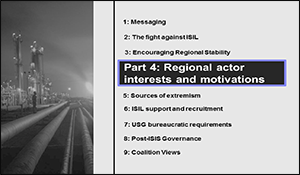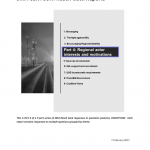Part 4 Actor Interests and Motivations

SMA CENTCOM Reach-back Reports – Part 4: Regional Actor Interests and Motivations.
Author | Editor: SMA Program Office.
This is Part 4 of a 9 part series of SMA Reach back responses to questions posed by USCENTCOM. Each report contains responses to multiple questions grouped by theme.
At the request of United States Central Command (USCENTCOM), the Joint Staff, Deputy Director for Global Operations (DDGO), jointly with other elements in the JS, Services, and U.S. Government (USG) Agencies, has established a SMA virtual reach-back cell. This initiative, based on the SMA global network of scholars and area experts, is providing USCENTCOM with population based and regional expertise in support of ongoing operations in the Iraq/Syria region.
The Strategic Multi-Layer Assessment (SMA) provides planning support to Commands with complex operational imperatives requiring multi-agency, multi-disciplinary solutions that are NOT within core Service/Agency competency. Solutions and participants are sought across USG and beyond. SMA is accepted and synchronized by Joint Staff (JS/J-3/DDGO) and executed by ASD(R&E)/EC&P/RRTO.
Responses were submitted to the following CENTCOM Questions:
- What are the strategic objectives and motivations of indigenous state and non-state partners in the counter-ISIL fight?
- In light of their divergent goals and interests, what are the necessary factors that would permit the U.S.- led Coalition, regional stakeholders (including Israel, Russia, and Iran), or jihadist groups to achieve their aims in Iraq? Where do disparate groups’ interests align and where do they diverge? What can the U.S. coalition do to deny adversaries the ability to achieve their goals?
- What are near and long term Turkish interests and intentions in Syria and Iraq? What are Turkish interests and intentions with respect to al-Bab?
- What internal factors would influence Iran’s decision to interfere with the free flow of commerce in the Strait of Hormuz or the Bab el Mandeb?
- What major economic, political and security (military) activities does KSA and Iran currently conduct in Bahrain, Lebanon, Iraq, Syria, and Yemen to gain influence? What are KSA and Iran’s ultimate goals behind these activities? What motivates KSA and Iran towards these goals? What future activities might KSA and Iran conduct in Bahrain, Lebanon, Iraq, Syria, and Yemen?
- What are the indicators of changes in Russian strategic interests in Syria?
- What are the aims and objectives of the Shia Militia Groups following the effective military defeat of Da’esh?
- What are the critical elements of a continued Coalition presence, following the effective military defeat of Da’esh [in Iraq] that Iran may view as beneficial?

Comments